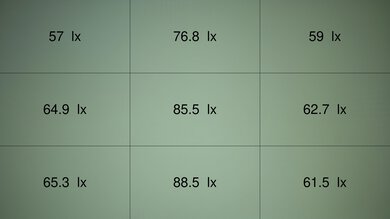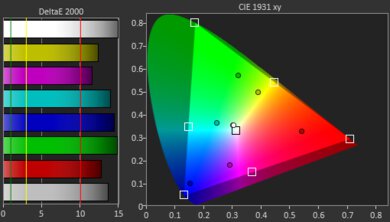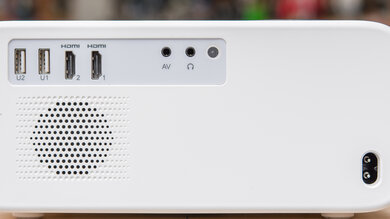The WiMiUS P63 is a portable entry-level projector with a 1080p native resolution. It's a fully featured projector with Android TV built-in, Bluetooth 5.2, and Wi-Fi 6 support. It also comes with EShare and Miracast for casting and screen mirroring, as well as many apps from the Google Play store. It has two HDMI ports, two USB ports, an AV-in port, and a headphone jack, so you can play media from a USB flash drive or SD card or plug in various devices via HDMI or its 3.5mm AV input. It can project a 30-inch image from a distance of 2.8 feet up to a massive 230-inch image from a distance of 21 feet, although the manufacturer recommends sticking to projecting from a distance of 3.3 feet to 11.5 feet for the best results. The projector comes with two integrated 10W speakers.
Our Verdict
The WiMiUS P63 is a poor choice for watching movies in a dark room. It has very bad color accuracy that you can't fix with calibration. It also has limited coverage of the Rec. 709 color space used with SDR content, so colors aren't properly displayed, although you're not likely to notice that due to how dim the projector is. The projector has noticeable vignetting in the corners of the screen, and it's so dim that you can't use it in a room with any ambient light. Fortunately, it has decent contrast, and blacks are deep in darker scenes but less so in near-black scenes or brighter ones.
-
Decent portability due to its size, weight, and auto vertical keystone.
-
Decent contrast for deep blacks during darker scenes.
-
Not useable in a room with lights due to its awful peak brightness.
-
Middling brightness uniformity with noticeable vignetting.
-
Inadequate coverage of the Rec. 709 color space used in SDR content and terrible color accuracy.
- 4.7 Movies
Changelog
-
Updated Nov 13, 2024:
We mentioned the newly reviewed NexiGo PJ40 (Gen 3) in the Contrast section of this review.
- Updated Aug 07, 2024: Mentioned the newly-reviewed LG CineBeam PF50KA in the Portability section of this review.
- Updated May 23, 2024: Review published.
- Updated May 21, 2024: Early access published.
- Updated May 09, 2024: Our testers have started testing this product.
Check Price
Differences Between Sizes And Variants
We bought and tested the WiMiUS P63 projector. WiMiUS has a wide selection of projectors available, including other products in the P line, like the P60, P62, and P64. Outside of different performance characteristics, there are slight differences between them. The cheaper P60 is the only projector of the four to have only Wi-Fi 5 and Bluetooth 5.1, while the other three have Wi-Fi 6 and Bluetooth 5.2. The more expensive P62 and P64 have full auto keystone correction as well as auto focus.
You can see the label here.
Compared To Other Projectors
The WiMiUS P63 is a poor projector, and we don't recommend buying it. Despite having decent contrast, it's so dim that it's unusable in a room with any lighting, and the colors are dull and severely inaccurate. It is, however, incredibly cheap and better than the similarly priced KODAK LUMA 150, although the KODAK is much more portable. If you're looking for something similar to the WiMiUS but at an even lower price, consider the VANKYO Leisure 470, which is dimmer than the P63 and doesn't have an integrated smart interface but has better contrast. If you're willing to spend more, consider the much brighter Epson EpiqVision Flex CO-W01.
Check out our recommendations for the best portable projectors and the best outdoor projectors. If you'd prefer to shop for another product in the same price range, look up the best projectors under $500 instead.
The NexiGo PJ40 (Gen 3) is better than the WiMiUS P63. The NexiGo is brighter, with much better contrast than the WiMiUS. While neither projector is colorful or accurate, the NexiGo is still the most colorful and accurate of the two. The one advantage of the WiMiUS is that it comes with a fully functioning Android TV implementation, while NexiGo's barebones implementation requires a streaming dongle to access any streaming apps. Otherwise, the NexiGo is clearly superior.
The WiMiUS P63 and KODAK LUMA 350 are equally good but have different strengths. The KODAK is incredibly portable and small enough to put in your pockets. The WiMiUS is also portable due to its relatively small size and auto keystone correction feature, although the KODAK also has that. The KODAK has a surprisingly wide color gamut compared to the very limited WiMiUS, but it doesn't really matter, as the two projectors are too dim to make colors pop. The WiMiUS P63 has the better contrast, so it gets the clear edge when used in a dark room.
The WiMiUS P63 is better than the KODAK LUMA 150, although the KODAK is much more portable because it's small enough to put in your pockets. The WiMiUS does have auto vertical keystone correction and a digital focus feature, both of which the KODAK lacks, so that helps when you want to move it around. The WiMiUS projects a sharper 1080p image than the KODAK's 480p, and it also has the better contrast of the two, on top of being a bit brighter. Finally, the WiMiUS has an integrated smart OS, while the KODAK doesn't.
The WiMiUS P63 is better than the VANKYO Leisure 470. The VANKYO is even less accurate than the already terribly inaccurate WiMiUS, and it doesn't have an integrated smart OS, while the WiMiUS comes with Android TV built-in. They're both dim projectors, but the WiMiUS is slightly brighter than the VANKYO. They're equally portable; the VANKYO is smaller than the WiMiUS. However, the latter compensates with auto vertical keystone correction and a nifty digital focus, making adjusting the projector from a distance easier.
The Epson EpiqVision Flex CO-W01 is better than the WiMiUS P63, although the WiMiUS is a bit more portable due to its slightly smaller size and auto vertical keystone feature. The WiMiUS also has a better contrast ratio, partly due to how dim it is; in comparison, the Epson is incredibly bright and can easily handle moderately lit rooms. It's also much more accurate than the WiMiUS, with a wider color gamut.
Test Results
The projector has decent portability. It's pretty lightweight and compact, but you need to plug it in since it lacks an internal battery. It has auto vertical keystone adjustment, making it easy to tilt or move up and down. It lacks auto-keystone on the horizontal axis, so you must manually adjust the screen geometry when moving the projector left or right. It doesn't have full auto-focus, but you can adjust the focus remotely with the remote, which is more convenient than adjusting it manually using a wheel. It has an adjustable central front foot that you can use to help raise or lower the projector. It also has two built-in 10W speakers. If you'd prefer a projector with an integrated battery, consider the LG CineBeam PF50KA.
The WiMiUS P63 has a native 1080p resolution but can accept signals of up to 4k resolution. It uses an LCD panel with an LED backlight, so you'll likely never need to replace it.
The WiMiUS P63 projector has poor brightness and middling uniformity. There is noticeable vignetting, with the sides being much dimmer than the center. It's not bright enough to be used in a room with ambient light, so it's best suited for a dark room.
The projector has a decent contrast ratio overall. It performs best in darker yet not quite pitch-black scenes, with deep blacks, but that's also partly due to the projector being so dim. In other scenes, whether they're nearly pitch black or on the brighter side, the projector's performance is satisfactory. If you're looking for a similar product but with better contrast, check out the NexiGo PJ40 (Gen 3) instead.
Unfortunately, this projector has very bad accuracy out of the box. All colors, more so blues and reds, are underrepresented in all shades of white, with the exception of blacks and near-blacks. Gamma is completely off the mark, so all scenes are way darker than they should be. Colors are so inaccurate that purples lean blue, blues lean cyan, cyans lean green, greens lean yellow, and yellows lean green. Most colors are also undersaturated. The projector does have decent color temperature; it's definitely too cold, giving everything a blue tint, but it's not too far from the calibration target of 6,500K.
The accuracy is still terrible after calibration since the projector has very limited calibration features. You're limited to adjusting picture mode settings, and by lowering contrast slightly while raising brightness, there's less clipping in real content and on clipping patterns, but it's minor. Otherwise, the same issues are present after calibration, with slightly improved color accuracy but less accurate color temperature.
The projector's color gamut is poor. It doesn't even cover close to the full range of colors in SDR content, and colors are displayed incorrectly, so whites and cyans lean green, purples lean blue, and greens and yellows lean toward each other. Its coverage of the wider Rec. 2020 color space is very limited and is significantly inaccurate across the board.
























